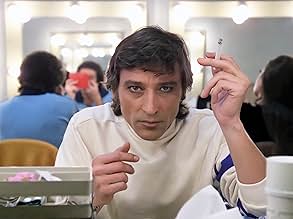PUNTUACIÓN EN IMDb
7,4/10
2 mil
TU PUNTUACIÓN
Un ballet flamenco lleva al escenario la obra de Lorca, una tragedia en la que un hombre prometido pero enamorado de su exnovia intenta recuperarla a pesar de sus inminentes nupcias.Un ballet flamenco lleva al escenario la obra de Lorca, una tragedia en la que un hombre prometido pero enamorado de su exnovia intenta recuperarla a pesar de sus inminentes nupcias.Un ballet flamenco lleva al escenario la obra de Lorca, una tragedia en la que un hombre prometido pero enamorado de su exnovia intenta recuperarla a pesar de sus inminentes nupcias.
- Premios
- 4 premios y 1 nominación en total
Juan Antonio Jiménez
- El Novio
- (as Juan Antonio Jimenez)
Candy Román
- Cuerpo de Baile
- (as Candy Roman)
José Mercé
- Cantaor
- (as Jose Merce)
Gómez de Jerez
- Cantaor
- (as Gomez de Jerez)
Argumento
¿Sabías que...?
- CuriosidadesIn 1968 it was announced that Anthony Quinn would star and direct this for MGM.
- PifiasAt the 23 minute mark, a very large, directional boom-microphone enters the upper left portion of the screen, lingers noticeably and then is removed.
- ConexionesFeatured in Cuando Franco murió, yo tenía 30 años (2005)
- Banda sonoraLa nana
Performed by Marisol
Reseña destacada
I am drawn to dance films, first for the dance itself, I marvel at how the human body can turn itself into visual music. But also for what dance can signify in a cinematic sense: the embodying of sense in form, the visual flow of consciousness, but where the camera is one of the dancers and wordlessly conveys whole essences in the space of what we see.
Here, I like the idea of centering the dance in the ordinary life that gives rise to it, so in the same flow we can pick up both improvised life and meticulous abstraction. We get the gathering of the troupe and preparations, the putting on of make-up and dressing-room small talk, the practice and rehearsal with its mistakes, and then a full dress rehearsal of the play instead of a big show.
My gripe is that so much more could've been made on the weaving of realities. We have a 'real' first half, but we're not immersed long enough to form connections. The feel like we are eavesdropping could be carried in the actual danced narrative, which is about secrets and watching. The energy and choreographed spillovers in the camera could be more rigorous, the flamenco more passionate. Imagine a mistake in the flow like in the first rehearsal, but they dance through it: how do we accommodate damage, chance, spontaneity?
As it is, there's too much theatric symmetry for me to like—not enough that is broken or alive. But at least the last scene is pretty amazing.
It's a knife fight between men for the eyes of the woman danced in slow-motion—the mirrored poise and grappling of pride mistaken as love, the arrested flow playing to the desired spectacle of manhood both by us and in the play, the ballet of camera singling again and again the knife, the woman's muted mimicked and impotent horror of watching. It's a lovely scene that I'll keep with me, a sort of visual carving in emotional time.
Here, I like the idea of centering the dance in the ordinary life that gives rise to it, so in the same flow we can pick up both improvised life and meticulous abstraction. We get the gathering of the troupe and preparations, the putting on of make-up and dressing-room small talk, the practice and rehearsal with its mistakes, and then a full dress rehearsal of the play instead of a big show.
My gripe is that so much more could've been made on the weaving of realities. We have a 'real' first half, but we're not immersed long enough to form connections. The feel like we are eavesdropping could be carried in the actual danced narrative, which is about secrets and watching. The energy and choreographed spillovers in the camera could be more rigorous, the flamenco more passionate. Imagine a mistake in the flow like in the first rehearsal, but they dance through it: how do we accommodate damage, chance, spontaneity?
As it is, there's too much theatric symmetry for me to like—not enough that is broken or alive. But at least the last scene is pretty amazing.
It's a knife fight between men for the eyes of the woman danced in slow-motion—the mirrored poise and grappling of pride mistaken as love, the arrested flow playing to the desired spectacle of manhood both by us and in the play, the ballet of camera singling again and again the knife, the woman's muted mimicked and impotent horror of watching. It's a lovely scene that I'll keep with me, a sort of visual carving in emotional time.
- chaos-rampant
- 28 jun 2013
- Enlace permanente
Selecciones populares
Inicia sesión para calificar y añadir a tu lista para recibir recomendaciones personalizadas
- How long is Blood Wedding?Con tecnología de Alexa
Detalles
- Fecha de lanzamiento
- Países de origen
- Sitio oficial
- Idioma
- Títulos en diferentes países
- Blood Wedding
- Empresa productora
- Ver más compañías en los créditos en IMDbPro
- Duración1 hora 12 minutos
- Mezcla de sonido
- Relación de aspecto
- 1.33 : 1
Contribuir a esta página
Sugerir un cambio o añadir el contenido que falta

Principal laguna de datos
By what name was Bodas de sangre (1981) officially released in India in English?
Responde





















